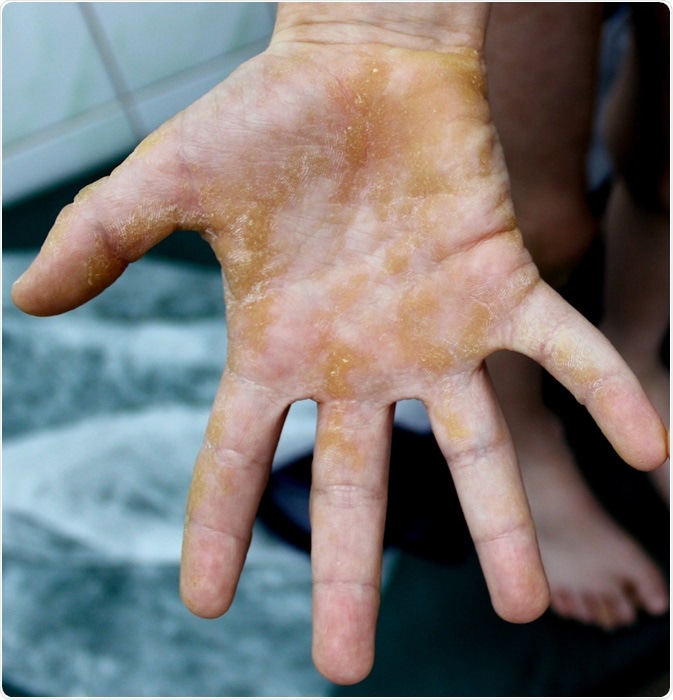Hyperkeratosis is the thickening of the outer layer of the skin, which contains a protein known as keratin. Keratin helps to protect the body against infiltration by water and other chemical and biological agents with which it comes in contact every day. The type of skin thickening found in hyperkeratosis is often a natural response to pressure, rubbing, or irritation of the skin, although there are a number of possible causes.

Image Credit: Dermatology11 / Shutterstock.com
Causes by type of hyperkeratosis
The type of hyperkeratosis is an important factor when discussing the cause of the condition. As such, the various forms with their likely causes are listed below:
- Warts: Warts are small bumps caused by an infection with human papillomavirus (HPV) that can arise anywhere on the skin, often on the hands and feet.
- Corns: Corns are a build-up of dead skin cells caused by repeated friction or pressure to the toes or other areas.
- Calluses: Calluses are an accumulation of dead skin cells due to repeated friction or pressure on the soles of the feet, palms of the hands, or other areas.
- Chronic eczema: Chronic eczema is associated with inflammation of the skin caused by allergies, irritants, or other triggers.
- Lichen planus: This condition is characterized by lacy white patches inside the mouth and/or itchy, scaly, and violaceous patches on the skin caused by an abnormal immune system response.
- Actinic keratosis: Actinic keratosis is characterized by flat, red patches of skin caused by excessive exposure to ultraviolet (UV) radiation from sunlight.
- Seborrheic keratosis: This condition is associated with small brown or black spots anywhere on the skin with no known cause.
- Inherited conditions: Other inherited hyperkeratosis conditions involve the development of thick and scaly skin caused by genetic susceptibility.
People who have dentures are more likely to have problems related to hyperkeratosis in the mouth. This is because ill-fitting dentures may rub against the skin in the mouth and cause the condition.
Genetic hyperkeratosis
In some cases, hyperkeratosis can occur on skin that has not been irritated or previously exposed to an infection. In such a case, it may be caused by an inherited condition. The signs of inherited keratosis usually begin in infancy or childhood and can affect large areas of the body. A widespread, thick, and scaly area is a characteristic sign of this type of hyperkeratosis.
A mutation in the KRT1 or KRT10 genes can cause epidermolytic hyperkeratosis. These genes are involved in the production of the keratin proteins 1 and 10, respectively, which are present in the epidermis of the skin and provide strength. A mutation in one of these genes can result in modified keratin proteins and affect the strength of the keratin in the epidermis. As a result, the skin may blister and become damaged easily, even in response to mild injury. It is not known how these mutations lead to hyperkeratosis.
Epidermolytic hyperkeratosis is usually inherited in an autosomal dominant pattern. This means that one copy of a mutated gene is able to cause the disorder and can be inherited from either parent. If one parent is affected, each child has a 50% chance of inheriting the disease. In rare cases, the KRT10 gene can be inherited in an autosomal recessive pattern, such that an individual must inherit a copy of a gene mutation from both parents in order to be affected.
However, people with no family history of epidermolytic hyperkeratosis are often affected, and a spontaneous gene mutation is thought to account for approximately half of all cases of the condition.
References
Further Reading